
Sawflies are the insects of the suborder Symphyta within the order Hymenoptera, alongside ants, bees, and wasps. The common name comes from the saw-like appearance of the ovipositor, which the females use to cut into the plants where they lay their eggs. The name is associated especially with the Tenthredinoidea, by far the largest superfamily in the suborder, with about 7,000 known species; in the entire suborder, there are 8,000 described species in more than 800 genera. Symphyta is paraphyletic, consisting of several basal groups within the order Hymenoptera, each one rooted inside the previous group, ending with the Apocrita which are not sawflies.

The Ichneumonidae, also known as ichneumon wasps, ichneumonid wasps, ichneumonids, or Darwin wasps, are a family of parasitoid wasps of the insect order Hymenoptera. They are one of the most diverse groups within the Hymenoptera with roughly 25,000 species currently described. However, this likely represents less than a quarter of their true richness as reliable estimates are lacking, along with much of the most basic knowledge about their ecology, distribution, and evolution. It is estimated that there are more species in this family than there are species of birds and mammals combined. Ichneumonid wasps, with very few exceptions, attack the immature stages of holometabolous insects and spiders, eventually killing their hosts. They thus fulfill an important role as regulators of insect populations, both in natural and semi-natural systems, making them promising agents for biological control.

Cryptinae is a subfamily of wasps in the family Ichneumonidae. The family has also been called Gelinae, Hemitelinae, and Phygadeuontinae by various authorities, though the Phygadeuontinae have since been elevated to a separate subfamily.

Rhagionidae or snipe flies are a small family of flies. They get their name from the similarity of their often prominent proboscis that looks like the beak of a snipe.

Agyrtidae, or primitive carrion beetles, are a small family of beetles belonging to Staphylinoidea. They are found in mostly temperate areas of the Northern Hemisphere and in New Zealand.

Banchinae is a subfamily of ichneumonid parasitoid wasps containing about 1,500 species; the genera Glypta and Lissonota are very large. The three tribes are all distributed worldwide.
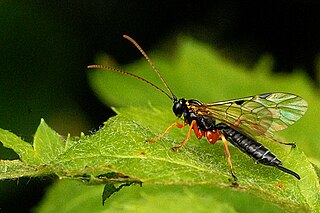
Pimplinae are a worldwide subfamily of the parasitic wasp family Ichneumonidae.

Acaenitinae is a subfamily of the parasitic wasp family Ichneumonidae. It is distributed on all continents except Antarctica, although only one specimen (from the genus Arotes has ever been discovered in South America. Little is known of the Acaenitinae. The only reared species was a koinobiont endoparasitoid of a weevil. There are 24 genera. Hosts are believed to be Coleoptera larvae in wood. Female Acaenitinae have a large triangular projecting genital plate.
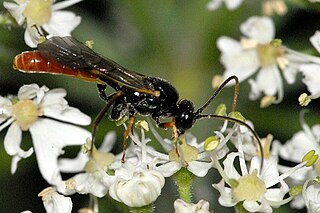
The Tryphoninae comprise a worldwide subfamily of the parasitic wasp family Ichneumonidae.
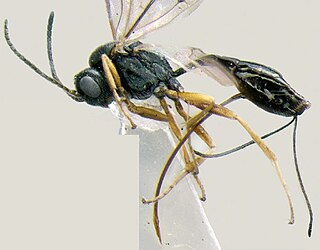
Tersilochinae is a worldwide subfamily of the parasitic wasp family Ichneumonidae.

Hemipenthes is a large genus of flies belonging to the family Bombyliidae (bee-flies). There are many described species, distributed throughout the Holarctic realm. These are small to large robust flies with a body length of 5–14 mm. They can be distinguished from similar genera (Villa) by their wing venation. A number of species formerly in this genus were moved to a separate genus, ins in 2020.

Allophrys is a genus of the parasitic wasp family Ichneumonidae.

Agroecomyrmecinae is a subfamily of ants containing two extant and two fossil genera. The subfamily was originally classified in 1930 by Carpenter as Agroecomyrmecini, a Myrmicinae tribe. Bolton raised the tribe to subfamily status in 2003, suggesting that Agroecomyrmecinae might be the sister taxon to Myrmicinae. It has since been discovered to be one of the earliest lineages of ants, a clade from the basal polytomy for all ants. In 2014, the subfamily was expanded to two tribes. The tribe Ankylomyrmini was moved from the subfamily Myrmicinae to Agroemyrmecinae.

Anthidiini is a tribe of insects in the family Megachilidae. There are at least 40 genera and 840 described species in Anthidiini. There is strong evidence that the tribe is monophyletic.
Synergini is a tribe of gall wasps in the subfamily Cynipinae.

Trogus is a genus of parasitoid wasp found in the Holarctic and Neotropic regions. It is placed in the subfamily Ichneumoninae and the tribe Ichneumonini. Trogus species are parasites of larvae and pupae of the swallowtail butterfly family, Papilionidae. The genus consists of twelve extant and one extinct species.
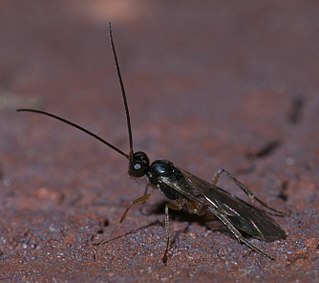
Phygadeuontini is a tribe of ichneumon wasps in the family Ichneumonidae. It is the only tribe in the subfamily Phygadeuontinae. There are about 123 genera in 12 subtribes worldwide.

Nasocorini is a tribe of plant bugs in the family Miridae. There are more than 50 genera in Nasocorini.
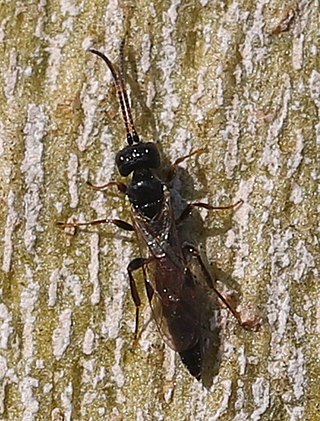
Phaeogenini is a tribe of ichneumon wasps in the family Ichneumonidae.


















